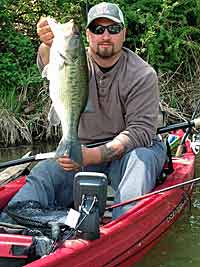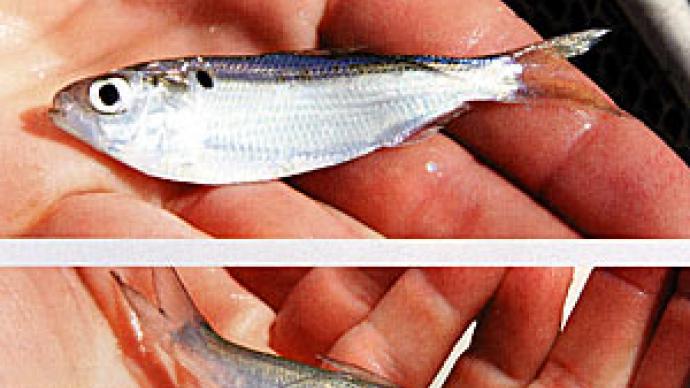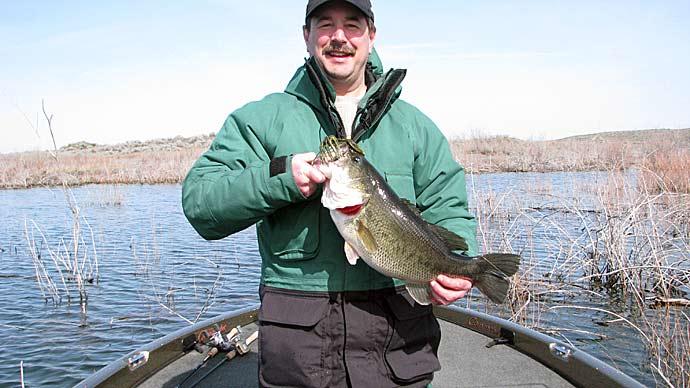
So, you want to grow trophy largemouth bass, eh? I wish I had a nickel for every time someone has spoken those words to me. As friend and avid Pond Boss reader Cleon Almond tells me, "Says easy, does hard."
Growing a truly huge bass is likened to winning the lottery. No, wait, it's more like the odds of being struck by lightening while you are safely asleep at home in bed. Well, that's not really quite true, either. The odds of being struck by lightning are probably more likely than growing a giant bass. Am I asking you to "settle" for a meager 10 pound bass? Maybe so, maybe no. If you understand the nature of growing huge bass, it will be much easier to understand the commitment it takes, and the consequences of that commitment.
Now that visual stage is set, it's time to come to a greater understanding what it takes to mentally approach the concept of raising trophy largemouth bass.
If someone were to ask you, "Where can we go to catch big bass?" you would likely have a response.. .maybe Lake Fork, Texas. But, if someone asks, "Where can we go troll for giant steelheads?" it wouldn't be Lake Fork, Texas. The real answers to both those questions start with habitat. Certain species of fish, certain sizes within those species, certain species of plants....must have particular habitat. Remember that. Fisheries management starts with habitat. Want to grow giant bass? You must have habitat for spawning, for young bass to feed and grow, for yearling bass, intermediate bass, adult bass, and topped off with the best giant bass habitat. But, that's not all. What do different size bass eat? Great managers provide "perfect" habitat for forage fish, too.
When someone advises a landowner to build a pond, stock it with the "right" ratios of forage fish, then the right numbers of bass, then fertilize, feed, sample and analyze, understand these crucial decisions are not the only means to an end. There are a few fundamental philosophical issues to deal with, too.
On a dreary day in 1932, farmer George Perry couldn't get to the fields to plow. So, he did what he did on days like that. With his family fighting the losing odds of the depression, he headed to Montgomery Lake, in Georgia, to catch a few fish and put some meat on the table. The rest of the story is legendary, mythical. Talk with any avid bass fisherman and you will quickly have an opinion rendered as to the validity of Perry's 22 pound 4 ounce largemouth bass. That fish is recognized today as the world record. Troupes of people seek to break that age old record, and a few have come close. Only twelve bass since 1932 have broken the twenty pound mark. Twelve largemouth bass, in the entire world.
George Perry did what any red-blooded American in the depression would do. His family ate the fish. Only as an afterthought, on the way home to clean the creature, his fishing buddy friend suggested he enter a little known Field & Stream magazine contest for the biggest fish. Prizes were involved. Perry had the fish weighed on certified scales, witnessed, entered the contest, then took the fish home and ate it. No big deal. Oh yeah, he won the contest. Then, much later in his life, he became famous for that single fish.
Fast forward to the 21st century. Many private lakes are designed to produce giant bass. Forage fish are stocked, sometimes overstocked, to make sure bass can't swim an inch without sucking in a mouthful of food. Genetics are always considered. Lake managers pay special attention to selective harvest techniques. Great fisheries management. But, there's more.
As the manager, as the one in charge of that fishery, stay focused on the four key elements. You must do that. Here they are, in order. Get them out of order, don't expect great fish. Habitat, first. Focus on that. Next, food chain. If you feed them, they will grow. Third, genetics. Genetics are absolutely essential to producing trophy largemouth bass. Last, and probably the most important, once everything else is in place, is proper harvest.
Small bass live like small bass. They travel in schools, herding, ganging up on smaller fish, eating like the little machines they are. Larger bass feed on larger prey, and so on, up the food chain. Raising trophy bass is a delicate combination of cover, structure, forage fish, water quality, water chemistry, aquatic plants, genetics, and variety of size ranges of all species of fish. A huge part of the equation is the dynamics of change. Water changes, fish spawn, fish eat, are eaten. Plants come, plants go. Temperatures rise, temperatures fall. Weather influences growth patterns of fish, and impacts habitat and ever-changing dynamics. This is where most people lose ground. Most folks, including the best biologists in the world, don't have a good grasp on many of the factors which actually influence trophy largemouth bass. Take a look at California, for example. Castaic, Lake Casitas, Lake Poway, Lake Dixon... small drinking water impoundments near giant cities. These lakes have produced huge bass. But, what seems to be the limiting factor in these lakes is the fact they are regularly stocked with rainbow trout. Succulent rainbow trout, tossed into a bass factory. If the simple fact supplementally stocking forage size rainbow trout were the complete answer, someone somewhere would have duplicated it, with similar results. And, these famous California lakes, with or without trout, haven't yet broken the magic number of a world record. So, is the focus completely on the food chain for Florida strain bass?
Focus only on the food chain and expect to fail. Don't focus on the food chain and expect to fail.
Here's where philosophical attitudes play a huge role. Large bass grow huge in stages. Understand each stage, as it happens, and your odds of success rise. Don't get caught up in the fact that bass are hatched, eat and are eaten. That happens every day. Stay focused on providing habitat, food, genetics and harvest of each stage of bass life. Small fish need dense cover and tiny morsels of food. Intermediate size bass need medium size forage fish and moderately dense cover. Large bass eat large meals, often intermediate size bass, five to seven inch bluegill, threadfin shad, tilapia...anything and everything which fits into its mouth, and is moving.
Become an expert at raising forage fish and diversifying the food chain. Monitor bass growth rates, pay attention to productivity of your water. Know when each species of fish spawn. Enhance the gene pool of forage fish and largemouth bass every few years, to ensure fresh, known genetics. Understanding the biology of water yields phytoplankton, then zooplankton, then insects. Understanding fertility and plankton leads to a better understanding of the food chain for newly hatched fish and tiny insects. This is significant, especially considering it takes at least ten pounds of forage fish to grow one pound of largemouth bass. That's growing, folks, not maintaining.
When habitat, food chain and genetics fit, harvest becomes most crucial. A lake, managed for maximum productivity, reaches its maximum production level at some point. Fisheries managers call that status, "carrying capacity." As a manager, you get to figure out what that point is. Simply speaking, a unit of water can produce a given amount of living mass. Part of that mass is tied up in plants, some of it in insects, some in fish. Predators sit atop that food chain, and in largemouth bass lakes, guess who sits at the very top? Largemouth bass. Size distribution becomes an issue. So many mouths to feed, so much feed for them. Critical thinking comes into play at this crucial point. You must harvest bass, as your lake reaches maximum productivity and carrying capacity. If you don't harvest, the food chain suffers and bass growth rates decline, usually within a specific size range. When that happens, dynamics shift toward a bass heavy state, and the entire food chain is disrupted. If you don't harvest enough bass, the food chain declines, bass growth is interrupted. Harvest too many bass and expect the food chain for intermediate size bass to skyrocket, and food chains for the largest bass are disrupted. Remember, large bass eat large meals. Balance the food chain for the balance of bass.
I know...this seems too complicated to be fun. But, it's really huge fun, especially when you actually understand how all these different factors come together in the ultimate trophy bass fishery. So, a concise summary is in order. Here's the recipe to increase your odds of growing huge bass.
First, create the best habitat in the best quality of water. Clean water, cover, structure, spawning areas... winning combinations in the best lakes. Create cover for small fish, medium size fish and big fish. If you intend to stock different species of fish, think about the habitat those types of fish need. Provide the habitat.
Stay focused on the food chain...for all fish. It's actually more important to feed tiny fish than it is to feed big fish. Feed small fish and watch the big fish thrive. Fertility, feeding stations, water quality management, stages of plankton growth.. .keys to the success of food chain management.
Genetics are huge. Want giant bass? You must have Florida genetics. Could you be limited by geography? Sure. That's another story. But, don't stock Florida strain bass in the beginning and expect them to carry you straight to the top over the long haul. It won't work. Integrate genetics as an ongoing project. Fish grow, then breed. Recruitment inevitably impacts the quality of your fishery. If one of momma's boys breeds with her in three years, she won't know it, he won't know it...it's natural progression. It's also inbreeding. Add genetics from time to time.
If habitat is great, food chain is constantly worked for the best production of the most forage fish, and genetics are thoughtfully enhanced, selective harvest becomes the next test. Be picky about what is removed and what is released. The fishery tells you, if you listen. Weigh and measure as many bass as you can, as often as you can.
Habitat, Food Chain, Genetics and Selective Harvest. Solid fisheries management. Now, if the stars line up, and a few of your genetically superior aggressive fish actually survive to adulthood, you stand a chance to grow a bass well into double digits. Can you grow a ten pound bass? Yes, you can. Good management in a moderate environment increases your odds. Can you grow a thirteen pounder? Maybe. A fifteen pounder? Only if you approach your fishery with a well defined, well executed plan. A seventeen pound bass? Probably not. If you grow a seventeen pound largemouth bass, everything is perfect, your stars have lined up, and that bass is an anomaly. Congratulations..buy a lottery ticket right away. You have won.
Reprinted with permission from Pond Boss Magazine



